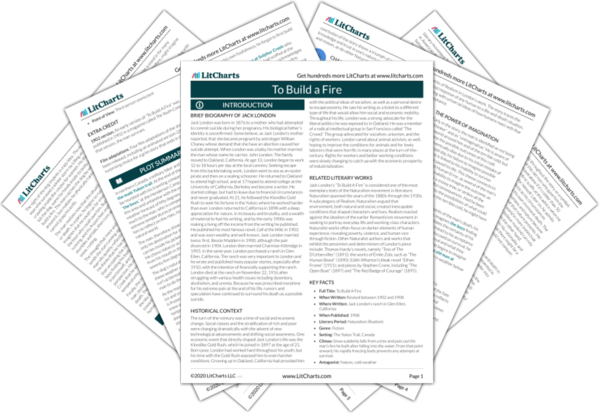Brief Biography of Jack London
Jack London was born in 1876 to a mother who had attempted to commit suicide during her pregnancy. His biological father’s identity is unconfirmed. Some believe, as Jack London’s mother reported, that she became pregnant by astrologer William Chaney whose demand that she have an abortion caused her suicide attempt. When London was a baby, his mother married the man whose name he carries: John London. The family moved to Oakland, California. At age 13, London began to work 12 to 18 hours per day at the local cannery. Seeking escape from this backbreaking work, London went to sea as an oyster pirate and then on a sealing schooner. He returned to Oakland to attend high school, and at 17 hoped to attend college at the University of California, Berkeley and become a writer. He started college, but had to leave due to financial circumstances and never graduated. At 21, he followed the Klondike Gold Rush to seek his fortune in the Yukon, where he worked harder than ever. London returned to California in 1898 with a deep appreciation for nature, in its beauty and brutality, and a wealth of material to fuel his writing, and by the early 1900s was making a living off the income from the writing he published. He published his most famous novel, Call of the Wild, in 1903 and was soon wealthy and well-known. Jack London married twice: first, Bessie Maddern in 1900, although the pair divorced in 1904. London then married Charmian Kittredge in 1905. In the same year, London purchased a ranch in Glen Ellen, California. The ranch was very important to London and he wrote and published many popular stories, especially after 1910, with the intention of financially supporting the ranch. London died at the ranch on November 22, 1916 after struggling with various health issues including dysentery, alcoholism, and uremia. Because he was prescribed morphine for his extreme pain at the end of his life, rumors and speculation have continued to surround his death as a possible suicide.
Historical Context of To Build a Fire
The turn-of-the-century was a time of social and economic change. Social classes and the stratification of rich and poor were changing dramatically with the advent of new technological advancements and shifting social awareness. One economic event that directly shaped Jack London’s life was the Klondike Gold Rush, which he joined in 1897 at the age of 21. Born poor, London had worked hard throughout his youth, but his time with the Gold Rush exposed him to even harsher conditions. Growing up in Oakland, California had provided him with the political ideas of socialism, as well as a personal desire to escape poverty. He saw his writing as a ticket to a different type of life that would allow him social and economic mobility. Throughout his life, London was a strong advocate for the liberal politics he was exposed to in Oakland. He was a member of a radical intellectual group in San Francisco called “The Crowd.” The group advocated for socialism, unionism, and the rights of workers. London cared about animal activism, as well, hoping to improve the conditions for animals and for lowly laborers that were horrific in many places at the turn-of-the-century. Rights for workers and better working conditions were slowly changing to catch up with the economic prosperity of industrialization.
Other Books Related to To Build a Fire
Jack London’s “To Build A Fire” is considered one of the most exemplary texts of the Naturalism movement in literature. Naturalism spanned the years of the 1880s through the 1930s. A subcategory of Realism, Naturalism argued that environment, both natural and social, created inescapable conditions that shaped characters and lives. Realism reacted against the idealism of the earlier Romanticism movement in seeking to portray everyday life and working-class characters. Naturalist works often focus on darker elements of human experience, revealing poverty, violence, and human vice through fiction. Other Naturalist authors and works that exhibit the pessimism and determinism of London’s piece include: Thomas Hardy’s novels, namely “Tess of The D’Urbervilles” (1891); the works of Émile Zola, such as “The Human Beast” (1890); Edith Wharton’s bleak novel “Ethan Frome” (1911); and pieces by Stephen Crane, including “The Open Boat” (1897) and “The Red Badge of Courage” (1895).
Key Facts about To Build a Fire
-
Full Title: To Build A Fire
-
When Written: Revised between 1902 and 1908
-
Where Written: Jack London’s ranch in Glen Ellen, California
-
When Published: 1908
-
Literary Period: Naturalism (Realism)
-
Genre: Fiction
-
Setting: The Yukon Trail, Canada
-
Climax: Snow suddenly falls from a tree and puts out the man’s fire he built after falling into the water. From that point onward, his rapidly freezing body prevents any attempts at survival.
-
Antagonist: Nature, cold weather
-
Point of View: Third-person omniscient
Extra Credit for To Build a Fire
